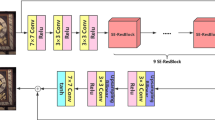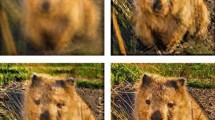Abstract
Blur is one of the common types of damage in the image. Image de-blurring is one of the biggest and most common challenges in the field of image processing. In this article, we present a suitable method for the caused blind blur removal by the motion in the image, in which, in addition to the original image recovery, we recover the kernel of the blur, which is the unknown. The blur kernel is a function that describes the amount and type of blur caused by imaging a point source of light. In our article, the end-to-end learning method for motion blur removal is presented. The presented learning in this paper is the basis of the content loss and the conditional generative adversarial networks. This method gets advanced efficiency in terms of the appearance of the visual and the similarity of the structure. This approach is faster than five times over similar methods. Also, we introduce a new method for artificial motion blur image generation from sharp images that provides the possibility of the increase of the real data. Although the focus of this article is on the removal of the caused blur by the motion on the natural images, our presented approach is capable of removing blur on text images as well, and it partially covers the blur that varies with the location. According to the comparison of existing approaches and the conducted tests, our presented approach has the greatest image output quality value in terms of peak signal-to-noise ratio parameters.
















Similar content being viewed by others
Abbreviations
- \({L}_{G}\) :
-
The combination loss
- \({L}_{{G}_{\mathrm{adv}}}\) :
-
The adversarial loss function
- \(\varphi .\gamma\) :
-
The impact factors
- \({L}_{OCD}\) :
-
The training loss function
- \({L}_{\mathrm{content}}\) :
-
The function of the content loss
- \({G}_{\theta }({I}^{B})\) :
-
The image of the produced sharp from a blurred image \({I}^{B}\)
- \({W}_{i.j}.{H}_{i.j}\) :
-
The specification mappings dimensions
- \({\varphi }_{i.j}\) :
-
A specifications mapping that is got with the layer of the complexity \(j\)
- \({I}^{S}.{I}^{B}\) :
-
The main hidden sharp images
- \({D}_{w}\) :
-
The separator by the parameters of the weight \(w\) which should be learned
- \(E\) :
-
The operator of the expectation
- \(\widehat{I}\) :
-
The original image
- \({G}_{\theta }\) :
-
A generator by the parameters of the weight \(\theta\)
References
R. Wang, D. Tao, Recent progress in image deblurring, arXiv preprint arXiv:1409.6838 (2014)
S. Yadav, C. Jain, A. Chugh, Evaluation of image deblurring techniques. Int. J. Comput. Appl.Comput. Appl. 139(12), 32–36 (2016)
A. Kheradmand, P. Milanfar, A general framework for regularized, similarity-based image restoration. IEEE Trans. Image Process. 23(12), 5136–5151 (2014)
L. Xiao, J. Gregson, F. Heide, W. Heidrich, Stochastic blind motion deblurring. IEEE Trans. Image Process. 24(10), 3071–3085 (2015)
R. Fergus, B. Singh, A. Hertzmann, S.T. Roweis, W.T. Freeman, Removing camera shake from a single photograph, in Acm Siggraph 2006 Papers, pp. 787–794 (2006)
Q. Shan, J. Jia, A. Agarwala, High-quality motion deblurring from a single image. Acm Trans. Graph. (tog) 27(3), 1–10 (2008)
A. Levin, Y. Weiss, F. Durand, W.T. Freeman, Understanding and evaluating blind deconvolution algorithms, in 2009 IEEE Conference on Computer Vision and Pattern Recognition, pp. 1964–1971 (IEEE, 2009)
S. Cho, S. Lee, Fast motion deblurring, in ACM SIGGRAPH Asia 2009 Papers, pp. 1–8 (2009)
L. Alvarez, L. Mazorra, Signal and image restoration using shock filters and anisotropic diffusion. SIAM J. Numer. Anal. Numer. Anal. 31(2), 590–605 (1994)
J.H. Money, S.H. Kang, Total variation minimizing blind deconvolution with shock filter reference. Image Vis. Comput.Comput. 26(2), 302–314 (2008)
J. Pan, R. Liu, Z. Su, X. Gu, Kernel estimation from salient structure for robust motion deblurring. Signal Process. Image Commun. 28(9), 1156–1170 (2013)
L. Xu, S. Zheng, J. Jia, Unnatural l0 sparse representation for natural image deblurring, in Proceedings of the IEEE Conference on Computer Vision and Pattern Recognition, pp. 1107–1114 (2013)
L. Xu, J. Jia, Two-phase kernel estimation for robust motion deblurring, in Computer Vision–ECCV 2010: 11th European Conference on Computer Vision, Heraklion, Crete, Greece, September 5–11, 2010, Proceedings, Part I 11, 157–170 (Springer, 2010)
I. Goodfellow, J. Pouget-Abadie, M. Mirza, B. Xu, D. Warde-Farley, S. Ozair, A. Courville, Y. Bengio, Generative adversarial nets, Adv. Neural Inf. Process Syst. 27 (2014)
O. Kupyn, V. Budzan, M. Mykhailych, D. Mishkin, J. Matas, Deblurgan: Blind motion deblurring using conditional adversarial networks, in Proceedings of the IEEE Conference on Computer Vision and Pattern Recognition, pp. 8183–8192 (2018)
J. Johnson, A. Alahi, L. Fei-Fei, Perceptual losses for real-time style transfer and super-resolution, in Computer Vision–ECCV 2016: 14th European Conference, Amsterdam, The Netherlands, October 11–14, 2016, Proceedings, Part II 14, pp. 694–711 (Springer, 2016)
I. Gulrajani, F. Ahmed, M. Arjovsky, V. Dumoulin, A.C. Courville, Improved training of wasserstein gans, Adv Neural Inf Process Syst 30 (2017)
S. Nah, T. Hyun Kim, K. Mu Lee, Deep multi-scale convolutional neural network for dynamic scene deblurring, in Proceedings of the IEEE Conference on Computer Vision and Pattern Recognition, pp. 3883–3891 (2017)
R. Köhler, M. Hirsch, B. Mohler, B. Schölkopf, S. Harmeling, Recording and playback of camera shake: Benchmarking blind deconvolution with a real-world database, in Computer Vision–ECCV 2012: 12th European Conference on Computer Vision, Florence, Italy, October 7–13, 2012, Proceedings, Part VII 12, pp. 27–40 (Springer, 2012)
J. Sun, W. Cao, Z. Xu, J. Ponce, Learning a convolutional neural network for non-uniform motion blur removal, in Proceedings of the IEEE Conference on Computer Vision and Pattern Recognition, pp. 769–777 (2015)
Y. Yang, W. Li, T.A. Gulliver, S. Li, Bayesian deep learning-based probabilistic load forecasting in smart grids. IEEE Trans. Ind. Inf.Ind. Inf. 16(7), 4703–4713 (2020). https://doi.org/10.1109/TII.2019.2942353
O. Abedinia, M. Bagheri, Execution of synthetic Bayesian model average for solar energy forecasting. IET Renew. Power Gener.Gener. 16(6), 1134–1147 (2022). https://doi.org/10.1049/rpg2.12389
O. Abedinia, M. Bagheri, V.G. Agelidis, Application of an adaptive Bayesian-based model for probabilistic and deterministic PV forecasting. IET Renew. Power Gener.Gener. 15(12), 2699–2714 (2021). https://doi.org/10.1049/rpg2.12194
A. Noruzi, T. Banki, O. Abedinia, N. Ghadimi, A new method for probabilistic assessments in power systems, combining monte carlo and stochastic-algebraic methods. Complexity 21(2), 100–110 (2014). https://doi.org/10.1002/cplx.21582
Funding
Anhui Provincial Natural Science Fund Project: Construction and Research of Text Sentiment Analysis Model Based on Deep Learning—Taking the Sentiment Orientation of Stock News as an Example (KJ2021A1531).
Author information
Authors and Affiliations
Corresponding author
Additional information
Publisher's Note
Springer Nature remains neutral with regard to jurisdictional claims in published maps and institutional affiliations.
Rights and permissions
Springer Nature or its licensor (e.g. a society or other partner) holds exclusive rights to this article under a publishing agreement with the author(s) or other rightsholder(s); author self-archiving of the accepted manuscript version of this article is solely governed by the terms of such publishing agreement and applicable law.
About this article
Cite this article
Jun, H. Presentation of a method for removal of motion blur effect in images by using GAN. J Opt (2023). https://doi.org/10.1007/s12596-023-01408-2
Received:
Accepted:
Published:
DOI: https://doi.org/10.1007/s12596-023-01408-2




